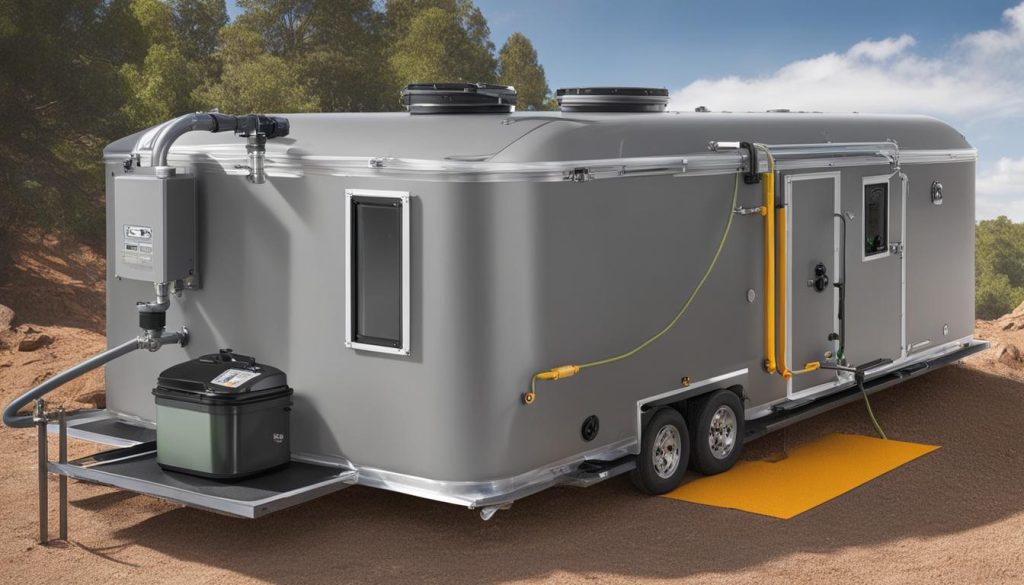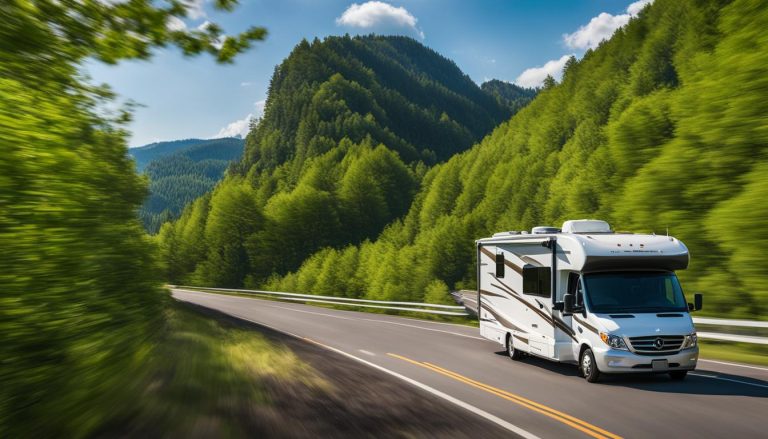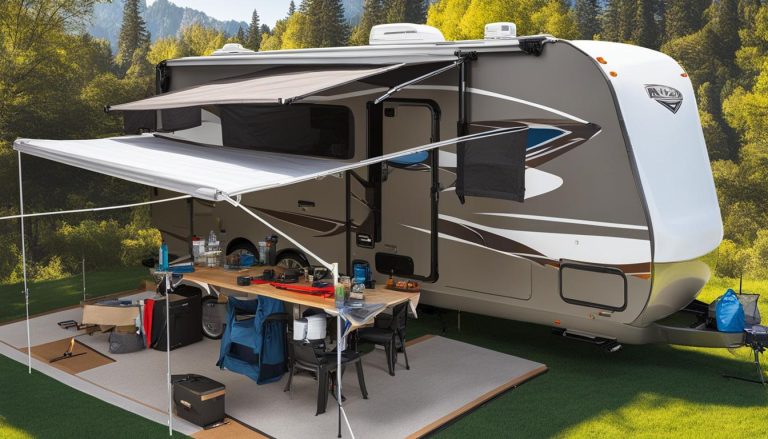Understanding Greywater in RVs: A Quick Guide
gorvlifestyle.com and its partners may earn a commission if you purchase a product through one of our links
Greywater in RVs refers to all the water that is used in the RV, excluding the water that flows out of the toilet. It includes water from showers, sinks, dishwashing, and laundry. Greywater is different from blackwater, which specifically refers to used water from the toilet. Both greywater and blackwater are found in RVs and are stored in separate tanks. Proper management and disposal of greywater in RVs is important to protect the environment and human health.
Key Takeaways:
- Greywater in RVs includes all water used in the RV except for toilet water.
- Greywater and blackwater should be stored in separate tanks.
- Proper management and disposal of greywater are essential for environmental protection.
- Greywater can be recycled for non-potable uses in some systems.
- Regularly check the levels of greywater in your RV and empty the tank when full.
What is Grey Water in an RV?
Grey water in an RV refers to all the water that is used in the RV, except for the water that is flushed down the toilet. It includes water from showers, sinks, dishwashing, and laundry. Grey water is similar to the grey water produced in a regular home. In contrast, black water in an RV specifically refers to the water that is flushed down the toilet. Understanding the difference between grey water and black water is important for properly managing and disposing of waste water in RVs.
Grey water in an RV refers to all the water that is used in the RV, except for the water that is flushed down the toilet.
Grey water in an RV is the waste water that is generated from various activities such as showering, washing dishes, and doing laundry. It is important to note that grey water does not include the water from the toilet as it falls under the category of black water. Grey water is similar to the grey water produced in a typical household, containing soap, dirt, food particles, and other contaminants.
Managing grey water in an RV is crucial to maintain sanitation and prevent environmental pollution. The proper collection, storage, and disposal of grey water are essential to protect natural water sources and ecosystems. Many RVs are equipped with separate tanks for grey water and black water, allowing for easy management and disposal.
Understanding the difference between grey water and black water is essential for RV owners. While grey water can be safely disposed of through environmentally friendly means, such as designated dump stations, black water requires specific treatment to prevent the spread of harmful bacteria and pathogens.
Grey Water Disposal Methods
When it comes to disposing of grey water in an RV, there are several options to consider:
- Dump Stations: Many campgrounds and RV parks have designated dump stations where you can safely dispose of your grey water. It’s important to follow the rules and regulations of the campground and ensure that the dumping process is done properly to prevent contamination.
- Portable Grey Water Tanks: Portable grey water tanks, also known as RV tote tanks, provide a convenient solution for emptying your grey water tank at your campsite without having to drive to a dump station. These tanks can be easily hooked up to your RV’s grey water tank for transferring the grey water.
By understanding what grey water is in an RV and how to properly manage and dispose of it, RV owners can ensure a clean and eco-friendly camping experience.
How to Dispose of Grey Water in an RV
Properly disposing of grey water in an RV is essential to protect the environment and prevent contamination.
While it may be tempting to dump grey water on the ground, this is not recommended unless allowed by the campground and not near a river or lake. Most well-developed campgrounds have designated dump stations where you can empty your grey water tank. If you’re renting an RV, you may also have the option to dump your waste water at the rental location.
It’s important to regularly check the levels of grey water in your RV and empty the tank when it is full.
Here are some tips for proper grey water disposal in an RV:
- Check campground rules: Ensure you are aware of the specific regulations regarding grey water disposal at the campground you are staying in. Different campgrounds may have different guidelines, so it’s important to follow them to avoid any penalties or harm to the environment.
- Use designated dump stations: Most campgrounds provide designated dump stations for disposing of grey water. These stations are equipped with the necessary facilities to safely dispose of your waste water. Follow the instructions posted at the dump station for proper disposal.
- Consider a portable grey water tank: If you’re staying at a campground without a dump station or if you prefer a more convenient option, you can invest in a portable grey water tank, also known as an RV tote tank. These tanks can be easily connected to your RV’s grey water tank, allowing you to transport the grey water to a designated dump station without having to move your entire RV.
- Never dump grey water in prohibited areas: Dumping grey water in prohibited areas, such as rivers, lakes, or on the ground, can have severe environmental consequences. Always follow the guidelines and restrictions set by the campground to ensure responsible and sustainable grey water disposal.
By following these tips and guidelines, you can effectively manage and dispose of grey water in your RV, minimizing your impact on the environment and ensuring a clean and enjoyable camping experience.

The Importance of Proper Grey Water Management
Proper grey water management is crucial for maintaining sanitation and protecting the environment while RV camping. Failing to properly manage grey water can lead to contaminants entering the soil and water sources, posing a risk to both human health and ecosystems.
“Grey water, if not managed correctly, can have a significant impact on the environment and human health. It’s essential to understand the importance of responsible grey water disposal and recycling in RVs.”
One of the key benefits of grey water management is the potential for recycling. Grey water can be recycled for non-potable uses such as irrigation or flushing toilets in some systems. By implementing grey water recycling systems in RVs, you can help conserve water and reduce the impact on the environment.
It’s crucial to follow campground rules and regulations regarding grey water disposal to ensure responsible and sustainable RV camping. Many campgrounds have designated areas or dump stations for grey water disposal. By adhering to these guidelines, you can minimize the risk of contamination and protect the natural beauty of the camping environment.
The Benefits of Grey Water Recycling
Grey water recycling in RVs offers several advantages:
- Water Conservation: Recycling grey water allows you to reuse water that would otherwise be wasted, helping to conserve this precious resource.
- Reduced Environmental Impact: By recycling grey water, you can minimize the amount of wastewater that is released into the environment, reducing the potential for contamination.
- Cost Savings: Utilizing recycled grey water can help lower water consumption and reduce expenses associated with water usage.
Implementing grey water management systems and recycling practices in RVs is a responsible and sustainable approach to camping. By taking the necessary steps to properly manage and dispose of grey water, you can contribute to the preservation of the natural environment and protect the health and well-being of future generations.
Remember, always check with campground regulations and local guidelines to ensure you are following the proper procedures for grey water disposal and recycling.
Comparison of Grey Water Management Methods
| Methods | Benefits | Considerations |
|---|---|---|
| Grey Water Recycling Systems |
|
|
| Designated Dump Stations |
|
|
| Portable Grey Water Tanks |
|
|

Tips for Checking Grey Water Levels and Dumping
Regularly checking the levels of grey water in your RV is essential to prevent overfilling and potential leaks or damage. In older RV models, you may notice that the shower water is not draining properly when the grey water tank is full. Newer models often have utility panels that display the grey water level.
Tip 1: To check the grey water level in your RV, locate the utility panel, which is usually found near your RV’s control panel. The utility panel displays the levels of your RV’s tanks, including the grey water tank. Make it a habit to check the grey water level daily or every few days to ensure it doesn’t exceed capacity.
Tip 2: In case your RV doesn’t have a utility panel, you can use a manual dipstick or measuring rod to check the grey water level. Insert the dipstick into the grey water tank until it reaches the bottom, and then pull it out. The wet portion of the dipstick indicates the current level of grey water in your tank.
Quote: “Checking the grey water levels regularly allows you to stay ahead of potential issues and ensures you have enough capacity for your upcoming travels.” – RV expert, Sarah Johnson
It’s important to dump your grey water tank before it becomes too full to avoid potential spills or backups. When dumping the grey water, it’s recommended to do it at designated dump stations and follow proper procedures to prevent contamination and environmental harm.
- Tip 3: Locate the nearest designated RV dump station in your area or at your campground. These stations are equipped with the necessary infrastructure to safely dispose of waste water.
- Tip 4: Before dumping the grey water, make sure you have the necessary tools, such as a sewer hose, gloves, and a bucket for rinsing. These will help facilitate a smooth and sanitary dumping process.
- Tip 5: When dumping the grey water, connect the sewer hose to the grey water outlet on your RV and insert the other end into the dump station’s receptacle. Open the grey water valve gradually to allow a controlled flow of water.
- Tip 6: Monitor the dumping process and ensure that the grey water flows smoothly without any blockages. Once the tank is empty, close the grey water valve and rinse the sewer hose and any other equipment used.
Avoid dumping your grey water in unauthorized areas, as it can lead to pollution and harm the environment. By following these tips for checking grey water levels and proper dumping procedures, you can maintain a clean and efficient RV waste water system.
Portable Grey Water Tanks for Easy Disposal
If you’re looking for a convenient solution to empty your RV’s grey water tank without the hassle of disconnecting and driving to a dump station, consider using portable grey water tanks, also known as RV tote tanks. These tanks offer a practical way to transfer your grey water at your campsite.
With portable grey water tanks, you can easily hook them up to your RV’s grey water tank, allowing for seamless transfer of the grey water. This eliminates the need to unhook everything and drive to a dump station, saving you valuable time and effort during your camping trip.
Portable grey water tanks are particularly beneficial for extended stays at one campground. By utilizing a portable grey water tank, you can conveniently transport the grey water to the dump station while keeping your campsite set up and enjoying your surroundings with minimal disruption.
FAQ
What is greywater in an RV?
Greywater in an RV refers to all the water that is used in the RV, excluding the water that flows out of the toilet. It includes water from showers, sinks, dishwashing, and laundry. Greywater is different from blackwater, which specifically refers to used water from the toilet. Both greywater and blackwater are found in RVs and are stored in separate tanks.
How do you dispose of greywater in an RV?
Properly disposing of greywater in an RV is essential to protect the environment and prevent contamination. While it may be tempting to dump greywater on the ground, this is not recommended unless allowed by the campground and not near a river or lake. Most well-developed campgrounds have designated dump stations where you can empty your greywater tank. If you’re renting an RV, you may also have the option to dump your waste water at the rental location. It’s important to regularly check the levels of greywater in your RV and empty the tank when it is full.
Why is proper greywater management important?
Proper greywater management is crucial for maintaining sanitation and protecting the environment while RV camping. Failing to properly manage greywater can lead to contaminants entering the soil and water sources, posing a risk to both human health and ecosystems. Greywater can be recycled for non-potable uses such as irrigation or flushing toilets in some systems. Implementing greywater recycling systems in RVs can help conserve water and reduce the impact on the environment. It’s important to follow campground rules and regulations regarding greywater disposal to ensure responsible and sustainable RV camping.
How do you check greywater levels and dump the tank in an RV?
Regularly checking the levels of greywater in your RV is essential to prevent overfilling and potential leaks or damage. In older RV models, you may notice that the shower water is not draining properly when the greywater tank is full. Newer models often have utility panels that display the greywater level. It’s important to dump your greywater tank before it becomes too full to avoid potential spills or backups. When dumping the greywater, it’s recommended to do it at designated dump stations and follow proper procedures to prevent contamination and environmental harm.
What are portable greywater tanks and how do they work?
Portable greywater tanks, also known as RV tote tanks, provide a convenient solution for emptying your RV’s greywater tank at your campsite without having to disconnect and drive to a dump station. These tanks can be easily hooked up to your RV’s greywater tank for transferring the greywater. This eliminates the need to unhook everything and drive to a dump station, saving time and effort. Portable greywater tanks are especially useful for extended stays at one campground. By using a portable greywater tank, you can easily transport the greywater to the dump station while keeping your campsite set up.






